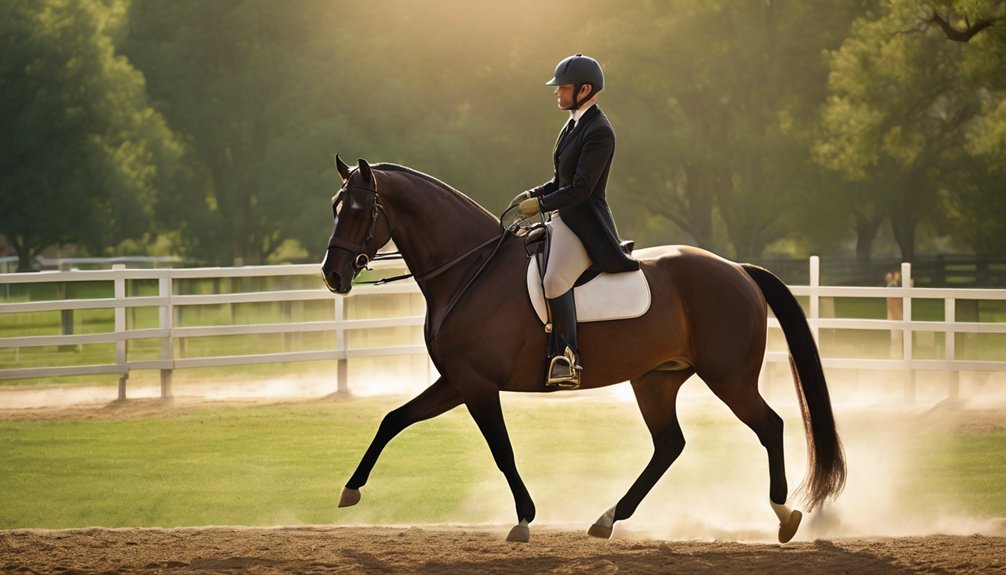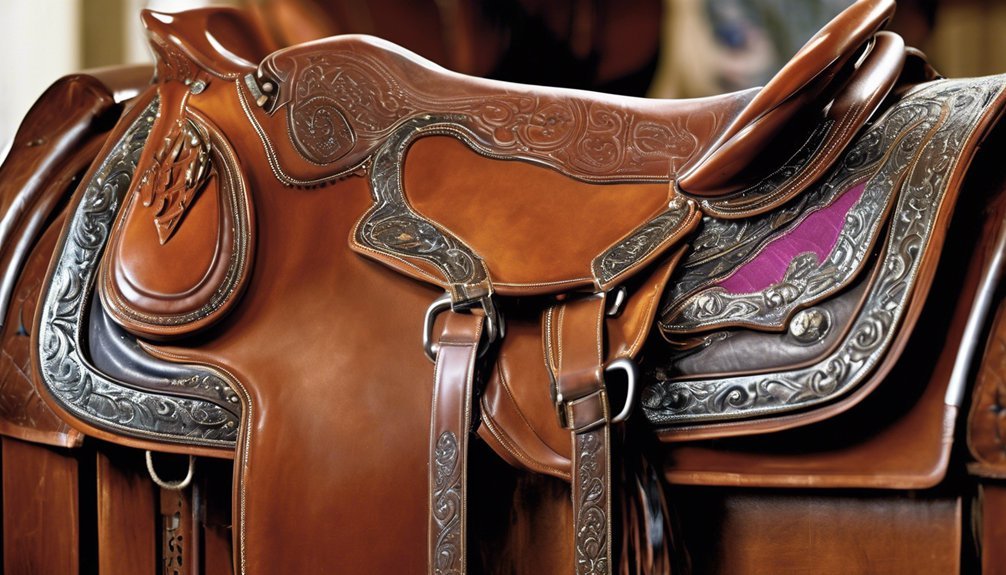
Navigating a show jumping course can feel like solving a complex puzzle, where every piece must fit perfectly to succeed. As you approach the course, you'll need to analyze its layout and strategize your jumps with precision. But how do you ensure that both you and your horse are in sync, ready to tackle the challenges ahead? Understanding the nuances of rhythm, pace, and communication can make all the difference in your performance.
Key Takeaways
- Familiarize yourself with the course layout and obstacle placement to plan your approach strategically.
- Walk the course to visualize the path, take-off, and landing spots for each jump.
- Establish a consistent rhythm and pace suited for both you and your horse throughout the course.
- Communicate effectively with your horse using clear cues and body language, ensuring a trusting partnership.
- Observe and learn from other riders' techniques and pacing to enhance your own performance.
Understanding the Course Layout

When you step into the arena, understanding the course layout is crucial for success. You'll want to take a moment to observe the course dimensions, noting how they influence your approach.
Look closely at the obstacle placement; each jump has been strategically positioned to test your skills. Visualize your path and think about how to navigate turns and distances effectively.
Familiarizing yourself with the layout helps you anticipate challenges and plan your ride. Remember, the flow of the course can impact your horse's rhythm, so stay aware of how each obstacle relates to the next.
Analyzing Jump Types and Heights
Jump types and heights play a significant role in shaping your approach to a show jumping course.
Understanding the jump specifications is crucial as they determine the technicality and challenge you'll face. Height adjustments can dramatically affect your strategy, so don't overlook them.
- Verticals: Straightforward, but can be daunting at height.
- Oxers: Wider jumps require more careful planning.
- Liverpool: Adds a psychological element with water underneath.
- Combination Jumps: Tests your horse's agility and your timing.
- Spread Jumps: Demand a strong take-off and landing.
Developing a Walking Plan
As you step onto the show jumping course, you'll want to develop a walking plan that allows you to visualize each jump and its corresponding line.
Start by mapping out your course strategy; identify the jumps that challenge you the most and note their distances. Observe how other riders tackle the course, and don't hesitate to jot down their techniques. This mental preparation will help you feel more confident and connected to your horse.
As you walk, picture yourself riding each line, focusing on your take-off and landing spots. Remember, every detail counts.
Creating a Rhythm and Pace

Having mapped out your course strategy, the next step is to establish a rhythm and pace that suits both you and your horse. This balance is crucial for a smooth ride and successful jumps.
Pay attention to your horse's natural stride and adjust your rhythm techniques accordingly.
- Maintain a consistent tempo to build confidence.
- Use your body to communicate with your horse.
- Make subtle pace adjustments before and after jumps.
- Practice transitions to enhance responsiveness.
- Observe other riders for inspiration on pacing.
Focusing on Lines and Turns
While navigating a show jumping course, focusing on lines and turns can significantly enhance your performance. Mastering line strategies is crucial; think of each jump as part of a fluid sequence. Maintain an even rhythm, allowing your horse to flow naturally from one fence to the next. Pay attention to your approach; the right angle can make all the difference.
When it comes to turn techniques, sharpness is key. Use your body and reins to guide your horse smoothly through each turn, ensuring you stay balanced and composed.
Building Trust and Communication With Your Horse
Navigating a show jumping course successfully goes beyond just mastering lines and turns; it also hinges on the bond you share with your horse.
Building trust and communication is crucial for peak performance. Engage in bonding exercises that deepen your connection and enhance understanding. Use effective cues to signal your intentions clearly and maintain a harmonious partnership.
- Spend quality time grooming to foster trust.
- Practice groundwork to enhance communication.
- Use consistent vocal commands during rides.
- Incorporate reward-based training to reinforce positive behavior.
- Attend workshops or clinics to learn from experienced riders.
As you strengthen this bond, you'll notice your horse responding more intuitively, making every jump feel like a shared adventure.
Practicing Your Approach to Jumps

As you prepare for a jump, the approach can make all the difference in your horse's confidence and your overall performance. Focus on your jumping techniques as you navigate each turn.
The right approach angle is crucial; it helps you set up for success and minimizes the risk of knocking down rails. Practice maintaining a steady rhythm, adjusting your speed and stride length as necessary.
Visualize the jump ahead, so you and your horse are in sync. Don't hesitate to experiment with different approach angles during practice sessions to find what works best for you both.
Mastering the Timing of Takeoff and Landing
How can you ensure your horse takes off and lands perfectly? Mastering the timing of takeoff and landing is crucial for a smooth round.
You'll want to develop a keen awareness of your horse's rhythm and energy, adjusting your approach accordingly. Here are some tips to enhance your takeoff timing and landing technique:
- Maintain a balanced position in the saddle.
- Keep an eye on your horse's stride pattern.
- Use your legs to encourage a powerful takeoff.
- Focus on a soft, controlled landing by relaxing your body.
- Practice consistently to build muscle memory.
Learning From Each Round
While every round may not go perfectly, each one offers valuable lessons that can elevate your riding skills. Use reflection techniques right after your round to pinpoint what worked and what didn't.
Think about your approach, your horse's response, and the distances you took. Gather insights during feedback sessions with your coach or peers; their perspectives can shine a light on aspects you might overlook.
Engage in open discussions about challenges you faced and celebrate the successes, no matter how small. Embrace these moments as they build your confidence and understanding.
Staying Calm and Confident Under Pressure
When you find yourself in the ring, the pressure can feel overwhelming, but staying calm and confident is crucial for success.
To maintain your composure, focus on these key strategies:
- Breath control: Take deep breaths to ground yourself and reduce anxiety.
- Mental visualization: Picture each jump and your horse's movements in your mind beforehand.
- Positive self-talk: Replace negative thoughts with affirmations that reinforce your skills.
- Routine practice: Familiarize yourself with the course during warm-ups to build confidence.
- Stay present: Concentrate on the moment, not the outcome, to help alleviate pressure.
Frequently Asked Questions
What Should I Wear for a Show Jumping Competition?
For a show jumping competition, you'll want to wear stylish show attire, like a fitted jacket and breeches, paired with essential safety gear, including a proper helmet and boots. Look sharp and feel confident!
How Do I Choose the Right Horse for Jumping?
When choosing the right horse for jumping, consider horse characteristics like temperament and athleticism. Ensure rider compatibility by assessing your experience and comfort level. A harmonious partnership makes all the difference in your jumping journey.
What Are Common Penalties in Show Jumping?
In show jumping, you'll encounter common penalties like knockdowns, refusals, and time faults. Each fault type adds penalty points, impacting your overall score. Understanding these can help you stay competitive and improve your performance.
How Can I Improve My Horse's Jumping Technique?
To sculpt your horse's jumping like a master artist, incorporate jumping exercises and technique drills into your routine. Observe their form, adjust accordingly, and celebrate each improvement, creating a bond that strengthens your partnership.
What Should I Do if I Fall off During a Round?
If you fall off during a round, prioritize your fall recovery. Stay calm, check for injuries, and use safety precautions like wearing a helmet. Getting back up is part of the journey; you're not alone in this.
Conclusion
So, you've got all this advice on navigating a show jumping course like a pro, but let's be real—who needs strategy when you can just wing it, right? Just toss your horse at the jumps and hope for the best! But in case you actually want to avoid a dramatic dismount or a tangled course, remember: practice, patience, and a little planning go a long way. After all, showing off your skills is much more fun than showing off your fall!





